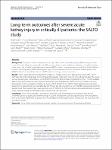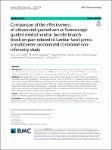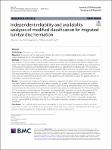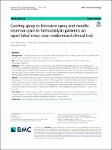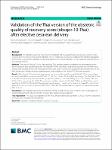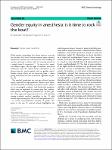Search
Author
- Daqing, Ma (3)
- Alexis, Ferré (2)
- Anna, Lybeck (2)
- Ashish K., Khanna (2)
- next >
Subject
- intensive care unit (8)
- acute respiratory dist... (5)
- chronic obstructive pu... (5)
- ICU (5)
- next >
Has File(s)
Search Results
Univariate and multivariate analysis with Cox model were used to identify risk factors associated with long-term mortality. Variables with p < 0.1 in the univariate analysis as well as those that are clinically important like severity, age and some comorbidities were included in the model. Schoenfeld residuals are presented in the supplementary appendix (Additional file 1: Figure S3) to check the proportional hazards assumption. We analyzed risk factors associated with the occurrence of WRF. In this context, we tested variables which have been reported to be potentially associated with worse renal outcomes (CKD, CCF, diabetes, age, hypertension, severity scores) [23]. We also assessed a potential association between RRT initiation strategy and WRF. |
Osteoarthritis (OA) is a chronic joint disease characterized by degenerative articular cartilage changes and secondary hyperosteogeny [1], affecting 10–15% of adults over the age of 60 worldwide [2]. OA is a major cause of disability, and its incidence, which is related to sex, age, obesity, joint trauma, and other factors, is on the rise, bringing a huge economic burden to patients and society [3, 4]. The pathogenesis of OA involves a redox state imbalance leading to oxidative stress, aging, and apoptosis in chondrocytes, as well as decreased anabolism and increased catabolism of the extracellular matrix [5, 6]. After articular cartilage injury, it is mainly repaired by the proliferation and differentiation of chondrocytes. However, the proliferative capacity of chondrocytes is lim... |
Lumbar facet joints (LFJ) syndrome is a common source of spinal suffering affecting up to 45% of patients with a chronic low back pain (LBP) because of inflammation, degenerative or arthritic changes, overload of the posterior LFJ or muscle imbalance [1,2,3,4,5,6]. It can be defined as a lumbosacral pain sometimes associated with sciatic pain that spread from any structure of facet/zygapophyseal joints [1,2,3,4,5,6]. Despite the high prevalence and the annual cost that it can generates, this syndrome is always difficult for pain doctors to take care of [5]. |
In this study, the incidence of migrated lumbar disc herniation was about 10.5%, and most of the patients were male. Patients with higher BMI are more likely to develop this disease. Our study confirmed that the modified classification has moderate to high confidence. During the 2-year follow-up period, 66 patients (62.9%) were treated conservatively, and the patients with conservative treatment were mainly A2 and B2 type (59.1%). Thirty-nine patients (37.1%) underwent surgical treatment. The patients recovered well after operation, and the low back pain and ODI index were significantly improved at 1 year after operation (P < 0.05). We suggest that type A1 and B1 migrated nucleus pulposus can be removed by posterior approach. For type A2, B2, C1, C2, the lateral approach is recommen... |
To provide an expert commentary on the impact of prior COVID-19 infection on patient’s surgical outcomes and postoperative recovery. To highlight the need for greater focus on peri-operative care of patients who have recovered from COVID-19. |
The telemedicine intensive care unit (Tele-ICU) is defined as a system in which intensive care professionals remotely provide care to critically ill patients and support the on-site staff in the intensive care unit (ICU) using secured audio–video and electronic links. Although the Tele-ICU is expected to resolve the shortage of intensivists and reduce the regional disparities in intensive care resources, the efficacy has not yet been evaluated in Japan because of a lack of clinically available system. |
The needle insertion pain to perform hemodialysis is the main challenge and a common problem that requires pain management techniques for patients’ comfort. |
The Obstetric Quality of Recovery score (ObsQoR-10) is a questionnaire used to assess recovery after cesarean delivery. However, the original ObsQoR-10 is in English and was mainly validated in the Western population. We therefore evaluated the reliability, validity, and responsiveness of the ObsQoR-10-Thai in patients undergoing elective cesarean delivery. |
Dexamethasone is commonly used for antiemesis in surgical patients. It has been confirmed that long-term steroid use increases blood glucose level in both diabetic and non-diabetic patients, it is unclear how a single dose of intravenous dexamethasone used pre/intraoperatively for postoperative nausea and vomiting (PONV) prophylaxis would influence the blood glucose and wound healing in diabetic patients. |
While gender inequalities have been reduced over the last decades, the United Nations women’s report recently showed that women are still restricted from working in certain industries in almost 50% of countries (based on a sample from 93 countries) [1]. On top of that, essential women’s rights, like the right to abortion, have been withdrawn from the United States constitution [2, 3], obstructing the much-needed road to gender equity. Gender equity, which we are discussing here, is about giving everybody the tools to succeed regardless of gender [4]. |

